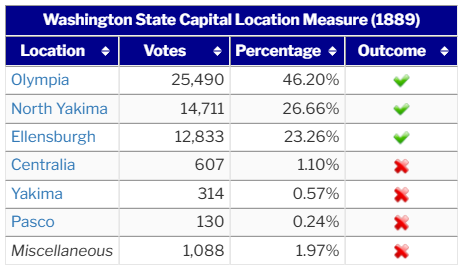Washington state residents voted on Oct. 1, 1889, to determine the location of the state capital. No one city achieved a majority, leading to an election between the top three in 1890.
The City of Olympia had acted as the capital for the Territory of Washington since 1853. With the people’s approval of the Washington Constitution at the same Oct. 1 election, the new State of Washington needed an official capital city.
The ballot measure was placed before the people to decide where the state capital would be located. Washington residents voted for their favored city; in the event that none achieved a majority vote, the top three cities would progress to the election on Nov. 4, 1890.

In September 1889, the Sunday Ledger Tacoma stated that due to their overwhelming popularity, only three cities were truly in the running for the state capital: North Yakima (today renamed as only ‘Yakima’), Olympia, and Ellensburg. When the election results were published, while election officials tallied votes for six different cities, those three cities had collectively received 96.1% of the vote.
Note that Ellensburg, presently spelled without an ‘h’ at the end, was spelled differently at the time of the election. Contemporary newspaper records referred to the city as Ellensburgh, with an ‘h.’ In contrast, the state’s election records spelled Ellensburg without the ‘h.’
Debates over the state capital’s location centered on whether geographical centrality or commercial activity should carry more weight. The Olympia Review published an article focused on the importance of the commercial activity of a capital city. It stated, “In selecting a capital more consideration should be given the business center of the state, than the geographic center. In these days of railroads and telegraphs, the latter counts for but little. The business center of Washington is, and will be, west of the mountains. The political center would better be near the business center. All interests and localities can better harmonize on Olympia than any place yet named.”
The Spokane Review published an article recognizing the importance of both attributes of a potential political city. It stated, “That the political center should of necessity be at the business center perhaps few will admit; and that Olympia is anywhere near the business center of the state of Washington certainly all will dispute. On the west side are Whatcom, Seattle, Port Townsend, Tacoma, and Gray’s Harbor. On the east side are Walla Walla, Dayton, Colfax, Ellensburgh, and Spokane Falls. In the center is North Yakima—sufficiently distant from each, sufficiently near to all."
Arguments in support of Ellensburg as the political city focused on a different advantage. An advertisement in the Sunday Tacoma Ledger stated that North Yakima and Olympia were already full of political influence and power, and that only by placing the capital city in Ellensburg would the state be “[setting] up housekeeping in a new house with clean surroundings, entirely free from all time-rooted territorial political ties and entanglements.”
Additionally, the varied spelling of Ellensburg became a point of debate in the election for the capital city. The Walla Walla Journal stated, “So long as Ellensburgh will insist on spelling the name with an ‘h’ at the end, we feel that the superfluous letter will be the straw that will break the camel’s back.”

Olympia, North Yakima, and Ellensburg, advanced as the top three choices for the state capital. On November 4, 1890, voters again faced the issue of the location of the Washington state capital on their ballots. In that election, 72.7% of voters chose Olympia as the state capital.



